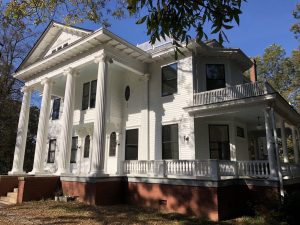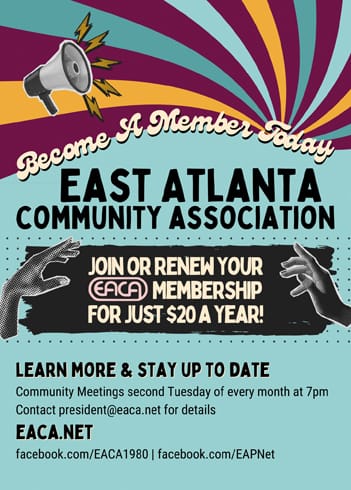By Robert Whittington Titus, Ron Lall, and Elizabeth Dillon
What is ‘Bus Rapid Transit’ (BRT) and why could it play a major role in the transformation of Moreland Avenue?
As stated within the Federal Transportation Administration (FTA) website, “BRT is an enhanced bus system that operates on bus lanes or other transit-ways in order to combine the flexibility of buses with the efficiency of rail. By doing so, BRT operates at faster speeds, provides greater service reliability and increased customer convenience. It also utilizes a combination of advanced technologies, infrastructure and operational investments that provide significantly better service than traditional bus service.”
A fairly non-specific proposed version of BRT has been approved and adopted for Moreland Avenue by MARTA and a newly formed regional transportation entity as a part of the “Concept 3” regional transportation plan, and is included in the Atlanta Regional Commission’s (ARC) “Plan 2040”. That means it has already been put in place to be considered for inclusion in those projects that might make it onto the regional HB277/TIA/TSPLOST referendum in 2012.
‘But how does this affect Moreland Avenue and those residing and working within its immediate area?’ Well, that is not such a simple answer. In an attempt to be concise, it is not just the BRT but what might go with it.
‘And what is that?’ one might ask. Well, therein rests the rest of the story…
BRT is a fairly well understood and widely accepted mass transit alternative. BRT systems in exotic locales like Brazil move as many as 250,000 people per day, roughly equivalent to that of MARTA’s heavy rail system. There are several primary versions of a BRT system, some of which may or may not be appropriate for Moreland Avenue. But the primary operational goal of BRT is aimed at creating a method of allowing buses to move people in a free-flowing manner, virtually or literally unrestricted by existing vehicular traffic, and then, when desired, perhaps continue a route through the normally regulated traffic system.
‘But… hey, wait a minute!’ one might exclaim, ‘how did this even get to be a consideration for Moreland Avenue?’
Well, it is perceived as a rational mass transit alternative that would play a major role in dealing with the region’s north-south connectivity issues, possibly linking communities as geographically and culturally distinctive and diverse as Buckhead and Clayton County, while providing a much more productive linkage with the MARTA rail stations at Inman Park/Reynoldstown and possibly Lenox Square. When combined with a much more vibrant bike and pedestrian environment in southeast Atlanta, it could bring many more people to and from East Atlanta Village, Glenwood Park, and the Edgewood Retail District while actually reducing the impact of vehicular traffic.
‘So, what does all of that mean? And what else goes with it anyway?’
Well, if it makes it onto the 2012 referendum list of projects, and the referendum is approved, it means that detailed planning efforts would begin almost immediately. It also means that a host of interrelated issues, like intersection improvements, signaling systems’ upgrades, certain bicycle and pedestrian facilities, traffic control measures and other management systems would be appropriately planned, funded and built within a relatively quick time frame.
What does ‘relatively quick’ mean?
We have been told that if funded within the HB277/TIA/TSPLOST referendum process it might mean project completion around 2014-15, but all of the projects voted on should be substantially underway or completed within a seven to eight year timeframe as currently proposed.
This also implies that the current transportation service structure of Moreland Ave would be significantly impacted, to the extent that other measures might be technically justified, studied and, if appropriate, implemented as envisioned within the South and North Moreland Livable Communities Initiatives (LCI), which have also been approved and adopted by the City of Atlanta and the Atlanta Regional Commission.
In fact, it is highly unlikely that a Moreland Ave BRT system would be created without taking into consideration and effectively dealing with the measures outlined by the South and North Moreland LCI initiatives.
‘OK, whew, what just does all this actually mean?’ one might respond.
Well, imagine less truck traffic, maybe wider sidewalks, and actual bike lanes- all made possible because there could be that much less vehicular traffic on Moreland. Or how about the most modern, maybe even natural gas/electric hybrid, buses running every 15 minutes between points south of Thomasville north to Lenox Square, and which almost never stop for a traffic light?
‘Okay, so who is supporting this BRT idea anyway?’
The East Atlanta Community Association (EACA), South Atlantans for Neighborhood Development (SAND), and Neighborhood Planning Unit W have voted to support efforts to put this specific transportation measure before the State’s Director of Transportation. Planning for inclusion in the ‘unconstricted’ list of projects being considered for the HB277/TIA/TSPLOST list of projects. Whether this then makes through a complex process of review and assessment is unknown, but the final list of projects to be voted on in the 2012 referendum will be finalized this fall.
To find out more about BRT, go to the Federal Transit Administration’s website at www.fta.dot.gov/assistance/technology/research_4240.html and for more about the South Moreland LCI, go to www.southstarcdc.org.









Be First to Comment